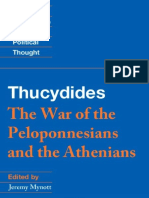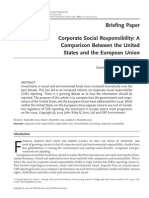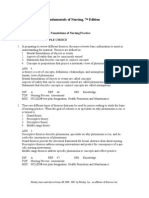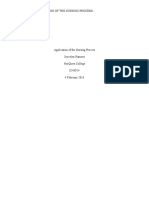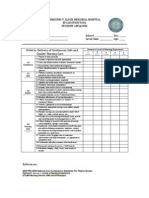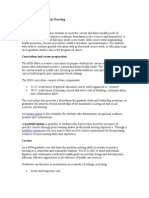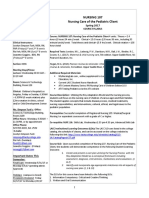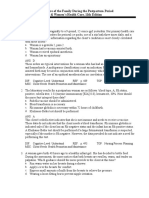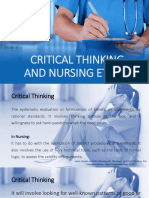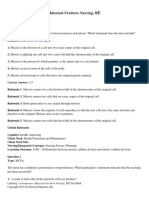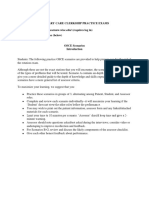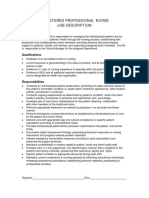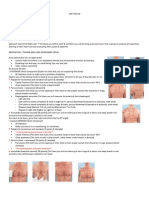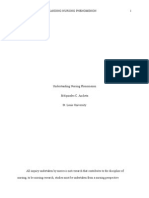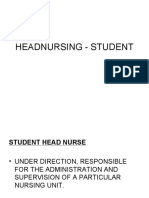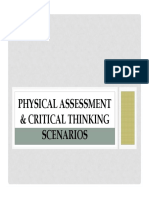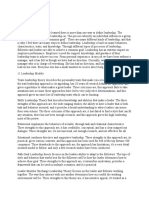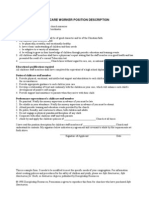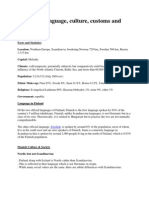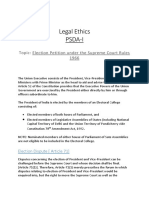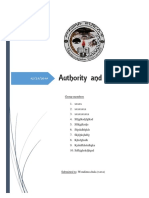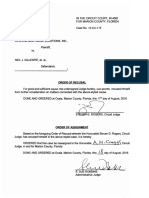Clinical Evaluation Tool Revised 8 12
Clinical Evaluation Tool Revised 8 12
Uploaded by
Kirandeep ParmarCopyright:
Available Formats
Clinical Evaluation Tool Revised 8 12
Clinical Evaluation Tool Revised 8 12
Uploaded by
Kirandeep ParmarOriginal Description:
Copyright
Available Formats
Share this document
Did you find this document useful?
Is this content inappropriate?
Copyright:
Available Formats
Clinical Evaluation Tool Revised 8 12
Clinical Evaluation Tool Revised 8 12
Uploaded by
Kirandeep ParmarCopyright:
Available Formats
1
Note: ALL text boxes in this document will expand as needed
when comments are added. JLD
UNC CHAPEL HILL SCHOOL OF NURSING
UNDERGRADUATE CLINICAL EVALUATION TOOL
Student : Faculty:
Course: Semester: Year: Clinical Site:
Introduction: This clinical evaluation tool consists of nine essential competencies with specific performance criteria. The nine competencies were
drawn from: terminal outcome objectives for the BSN program at UNC Chapel Hill School of Nursing, The Essentials of Baccalaureate Education
for Professional Nursing Practice (AACN, 2008), and Quality and Safety Education in Nursing (Cronenwett et al., 2007). The performance criteria
for each competency include cognitive, affective, and psychomotor domains of learning and provide a complete evaluation of an individual
student’s clinical performance. The use of this clinical evaluation tool makes it possible to see the student’s development over time as he/she
progresses through the specific course, as well as through the nursing curriculum. It also provides standard measures for student, course, and
program evaluation.
This clinical evaluation tool is to be used in each clinical course. A formal evaluation is completed and shared with the student at the
conclusion of the rotation. In some courses, faculty will also use this tool for mid-rotation evaluation. The tool can also be used at other
times during the rotation and can serve as the basis for a learning contract.
Instructions: Faculty will rate students on each of nine competencies using the designated rating scale, considering the quality of the
performance (Almost Never Exhibits to Almost Always Exhibits) and the amount of guidance required (Almost Always Requires to Almost
Never Requires). Referring to the scale below, as students improve in accuracy, safety, and efficiency, it is expected that they will require less
guidance. To determine the rating for each competency, faculty will consider student performance on the specific performance criteria and will
arrive at a rating for each competency using the 0-4 scale. Faculty may also include comments related to each competency. At the end of this
clinical evaluation tool, faculty should write summary comments and document recommendations for further development/improvement. The
faculty who wrote the evaluation will review it with the student and document the date of the meeting. The student should be provided with a copy
of the evaluation. Students may be asked to complete a self-evaluation at midterm and final. Clinical faculty should discuss the tool with students
at the beginning of each clinical rotation and describe how and when it will be used.
NOTE: In these competencies, client is defined as the recipient of professional nursing services and may be an individual, family, or group.
References Used for Tool Development
American Association of Colleges of Nursing. (2008). The essentials of baccalaureate education for professional nursing practice. Washington, DC: Author.
Cronenwett, L., Sherwood, G., Barnsteiner J., Disch, J., Johnson, J., Mitchell, P., Sullivan, D., & Warren, J. (2007). Quality and safety education for nurses. Nursing Outlook, 55,122-131.
Holaday, S., & Buckley, K. (2008). A standardized clinical evaluation tool-kit: Improving nursing education and practice. In M. H. Oermann & K. T. Heinrich (Eds.), Annual Review of Nursing Education,
Vol. 6. New York: Springer Publishing.
2
The Rating Scale
Self-Directed (4)
Almost Never Requires (<10% of the time) Almost Always Exhibits (>90% of the time)
direction monitoring a focus on the client or system efficiency and organization
guidance support accuracy, safety, and skillfulness an eagerness to learn
assertiveness and initiative
Supervised (3)
Occasionally Requires (25% of the time) Very Often Exhibits (75% of the time)
direction monitoring a focus on the client or system efficiency and organization
guidance support accuracy, safety, and skillfulness an eagerness to learn
assertiveness and initiative
Assisted (2)
Often Requires (50% of the time) Often Exhibits (50% of the time)
direction monitoring a focus on the client or system efficiency and organization
guidance support accuracy, safety, and skillfulness an eagerness to learn
assertiveness and initiative
Novice (1)
Very Often Requires (75% of the time) Occasionally Exhibits (25% of the time)
direction monitoring a focus on the client or system efficiency and organization
guidance support accuracy, safety, and skillfulness an eagerness to learn
assertiveness and initiative
Dependent (0)
Almost Always Requires (>90% of the time) Almost Never Exhibits (<10% of the time)
direction monitoring a focus on the client or system efficiency and organization
guidance support accuracy, safety, and skillfulness an eagerness to learn
assertiveness and initiative
Expected Levels of Performance: For the Final Evaluation students must achieve the minimal expected level of performance for each
competency in order to pass the course and progress in the program.
Level Minimum Expected Performance Minimum Score Upon Completion of:
I Novice — Assisted 1.5
II Assisted 2.0 First semester of clinical practice
III Assisted — Supervised 2.5 All interim semesters of clinical practice
IV Supervised — Self-directed 3.0 Final semester of clinical practice
3
Competencies, Performance Criteria, and Comments
1. Demonstrates professional behaviors
a. Follows university, school, and agency policies i. Incorporates constructive feedback for performance improvement
b. Practices within the legal and ethical frameworks of nursing j. Maintains professional appearance
c. Assumes accountability for own actions and practices k. Maintains professional attitude
d. Treats all individuals with dignity/respect l. Maintains professional behavior
e. Demonstrates cultural sensitivity m. Arrives on time for clinical
f. Protects client rights (privacy, autonomy, confidentiality) n. Notifies faculty in a timely manner if he/she will be absent or late
g. Demonstrates initiative in seeking learning opportunities and resources o. Prepares for clinical practice
h. Analyzes personal strengths and limitations in providing care p. Identifies situations in which assistance is needed OR appropriately seeks assistance
Faculty Comments MIDTERM Student Comments
Rating: Rating:
Faculty Comments FINAL Student Comments
Rating: Rating:
2. Collects and analyzes comprehensive client data
a. Determines relevant information needed d. Interprets laboratory/diagnostic test results
b. Identifies appropriate sources for data collection e. Incorporates data from client, family/support persons and health care team
c. Uses correct techniques for assessment members
Faculty Comments MIDTERM Student Comments
Rating: Rating:
Faculty Comments FINAL Student Comments
Rating: Rating:
3. Plans appropriate client care
a. Develops plan of care based on analysis of assessment data d. Considers needs/preferences of the client in planning care
b. Accurately determines priorities for care e. Establishes realistic goals/expected outcomes
c. Communicates priorities and rationale for decisions to instructor f. Identifies appropriate resources to inform care planning
Faculty Comments MIDTERM Student Comments
Rating: Rating:
Faculty Comments FINAL Student Comments
Rating: Rating:
4
4. Provides safe client-centered care
Safe Behavior Criteria: The student is required to practice professional nursing safely in specific client-centered situations with clinical
supervision. Safe behavior is defined as behavior which does not place the client or self and other professional staff at risk of physical and/or
psychosocial harm. The student is subject to receiving a Failure in the course and to being dismissed from the program if safe behavior is not
consistently demonstrated.
a. Plans and implements evidence-based interventions that are congruent with g. Takes appropriate steps to improve nursing skills and use of technologies
assessment data h. Creates a safe environment for client care
b. Considers client needs and preferences in providing care i. Demonstrates flexibility in adapting to changing client care situations
c. Performs nursing skills and therapeutic procedures safely and competently j. Reports abnormal data and changes in client condition to instructor or
d. Follows principles of infection control appropriate health team member
e. Follows procedures for medication administration k. Honors and promotes the rights of clients and others by acting on their
f. Recognizes own limitations related to nursing skills or technologies and behalf and in their best interest
takes appropriate steps for improvement
Faculty Comments MIDTERM Student Comments
Rating: Rating:
Faculty Comments FINAL Student Comments
Rating: Rating:
5. Engages in systematic and ongoing evaluation of the plan of care
a. Evaluates nursing interventions based on goals/expected outcomes c. Revises plan of care based on evaluation and consultation
b. Analyzes client data for accuracy and completeness d. Involves client, significant others, and health team members in evaluation
process as relevant
Faculty Comments MIDTERM Student Comments
Rating: Rating:
Faculty Comments FINAL Student Comments
Rating: Rating:
6. Applies knowledge relevant to client care
a. Demonstrates initiative to obtain needed knowledge e. Integrates concepts of health promotion and disease prevention
b. Evaluates sources of data for appropriateness, usefulness, and accuracy into client care
5
c. Integrates theory from nursing, natural and social sciences to enhance client f. Identifies issues/problems in nursing practice that need to be improved
care g. Evaluates nursing practices based on current research evidence
d. Relates pathophysiology and epidemiology of disease(s) to clients’
assessment findings, medications, laboratory and diagnostic test results,
medical and nursing interventions
Faculty Comments MIDTERM Student Comments
Rating: Rating:
Faculty Comments FINAL Student Comments
Rating: Rating:
7. Communicates effectively
a. Produces clear, relevant, organized, and thorough writing d. Listens attentively and respectfully to others
b. Exhibits timely, legally accurate, and appropriate documentation e. Is actively involved in team building, fostering collegiality, and encouraging
c. Communicates therapeutically with clients utilizing verbal and nonverbal cooperation
skills f. Contributes insight and helpful information to the health care team/group
conferences
Faculty Comments MIDTERM Student Comments
Rating: Rating:
Faculty Comments FINAL Student Comments
Rating: Rating:
8. Uses teaching-learning process when providing individualized client/family/group education
a. Assesses learning needs of clients, families, and groups e. Specifies reasonable and appropriate outcome measures
b. Assesses readiness for and barriers to learning f. Utilizes appropriate principles of teaching/learning when implementing a
c. Considers appropriate client characteristics in teaching (e.g., teaching plan
culture, age, developmental level, and educational level) g. Evaluates learner outcomes, provides feedback, and revises teaching plan
d. Develops an appropriate teaching plan for learner needs as needed
Faculty Comments MIDTERM Student Comments
Rating: Rating:
Faculty Comments FINAL Student Comments
Rating: Rating:
6
9. Exhibits caring to facilitate physical, mental, and spiritual health
a. Demonstrates sensitivity to cultural, moral, spiritual, and ethical beliefs of c. Protects the client’s safety and privacy, and preserves human dignity while
clients, families, peers, health care team members, and others providing care
b. Recognizes barriers to care such as socioeconomic factors, environmental d. Encourages family and/or significant others’ participation in care as
factors, and support systems appropriate
e. Assists clients with coping and adaptation strategies
Faculty Comments MIDTERM Student Comments
Rating: Rating:
Faculty Comments FINAL Student Comments
Rating: Rating:
Midterm Evaluation
Faculty Comments: Faculty recommendations for further development/improvement:
Final Evaluation
Faculty Comments: Faculty recommendations for further development/improvement:
By typing their names below, the student and the faculty acknowledge that a meeting was held on < date > to discuss this evaluation and that a copy of this evaluation
was provided to the student.
Student Signature: Date:
Faculty Signature: Date:
Revised 8/12
You might also like
- John Maxwell Leadership AssessmentDocument12 pagesJohn Maxwell Leadership AssessmentErwin Dave M. Dahao100% (1)
- Safety Unfolding Nursing Case StudyDocument3 pagesSafety Unfolding Nursing Case StudyclarimerNo ratings yet
- CHCPRT001 Identify and Respond To Children and Young People at Risk (5th Ed) - Short Answer OnlyDocument6 pagesCHCPRT001 Identify and Respond To Children and Young People at Risk (5th Ed) - Short Answer Onlypapuente75% (4)
- Thucydides - The War of The Peloponnesians and The AtheniansDocument755 pagesThucydides - The War of The Peloponnesians and The AtheniansZach Childress100% (4)
- Nursing Core CompetenciesDocument51 pagesNursing Core CompetenciesDRyzt Calimutan100% (1)
- Domain 1 Professional Responsibility PDFDocument2 pagesDomain 1 Professional Responsibility PDFamandeep kaurNo ratings yet
- Acetaminophen PDFDocument1 pageAcetaminophen PDFTommieNo ratings yet
- NRSG 7010 SyllabusDocument6 pagesNRSG 7010 Syllabusapi-310557802No ratings yet
- CSR-USA Vs EUDocument5 pagesCSR-USA Vs EUlightknowNo ratings yet
- Clinical Evaluation Tool Guidelines WUHS 2014Document3 pagesClinical Evaluation Tool Guidelines WUHS 2014Camille Tozca TupasNo ratings yet
- Chapter 025Document14 pagesChapter 025dtheart2821100% (2)
- Chapter 004Document10 pagesChapter 004Erika Midkiff100% (2)
- Midterm Evaluation - NaomiDocument11 pagesMidterm Evaluation - Naomiapi-643518482100% (1)
- MidtermDocument15 pagesMidtermapi-400034813No ratings yet
- Brendan Morano Final EvaluationDocument15 pagesBrendan Morano Final Evaluationapi-546391110No ratings yet
- Clinical TeachingDocument5 pagesClinical TeachingTobiDaNo ratings yet
- Nursing Process Assignment 2Document11 pagesNursing Process Assignment 2api-309812354100% (4)
- GTLMH Nursing Evaluation ToolDocument2 pagesGTLMH Nursing Evaluation ToolabcalagoNo ratings yet
- Bachelor of Science in NursingDocument19 pagesBachelor of Science in Nursingjigz010No ratings yet
- 6.underwater Seal Chest DrainageDocument22 pages6.underwater Seal Chest DrainageEvieta CallysthaNo ratings yet
- Evaluation ToolDocument3 pagesEvaluation Toolbulikako100% (1)
- FundamentalsDocument3 pagesFundamentalsKc AcainNo ratings yet
- Clinical Teaching Plan On Ncm-105 Psyhciatric NursingDocument13 pagesClinical Teaching Plan On Ncm-105 Psyhciatric NursingHazel RoseNo ratings yet
- Nurs1020 Clinical Midterm EvaluationDocument7 pagesNurs1020 Clinical Midterm Evaluationapi-456466614No ratings yet
- WCU APRN Student HandbookDocument17 pagesWCU APRN Student HandbookEllie MehrNo ratings yet
- PDP KmiuraDocument2 pagesPDP Kmiuraapi-295640482No ratings yet
- 107 SyllabusDocument24 pages107 Syllabuslelly LellyNo ratings yet
- Self Assessment - Midterm 2016Document11 pagesSelf Assessment - Midterm 2016api-341527743No ratings yet
- Chapter 21 - Nursing Care of The Family During The Postpartum PeriodDocument11 pagesChapter 21 - Nursing Care of The Family During The Postpartum PeriodJill Hill100% (3)
- Nurse PatientDocument37 pagesNurse PatientMary Margareth GonzalesNo ratings yet
- Newborn CompetencyDocument3 pagesNewborn CompetencyJem Tellain100% (1)
- Chapter 028Document15 pagesChapter 028dtheart2821100% (2)
- Critical Thinking and Nursing EthicsDocument12 pagesCritical Thinking and Nursing EthicsJudy MaeNo ratings yet
- Nurs 253 Student Self Evaluation-Oct23Document8 pagesNurs 253 Student Self Evaluation-Oct23api-283153412No ratings yet
- 1-1-2 Framework For Maternal and Child Health NursingDocument3 pages1-1-2 Framework For Maternal and Child Health NursingKimberly CostalesNo ratings yet
- Preceptorship Policy FinalDocument60 pagesPreceptorship Policy Finalሠጥአርግ አየነው100% (1)
- Final PRC Evaluation ToolDocument9 pagesFinal PRC Evaluation Toolbladimer_riaNo ratings yet
- Nurs 253 Student Self Evaluation-FinalDocument21 pagesNurs 253 Student Self Evaluation-Finalapi-2840945340% (1)
- Ladewig 8e TIF Ch04 PDFDocument12 pagesLadewig 8e TIF Ch04 PDFjames smithNo ratings yet
- Practice Exam: Https://learnuw - Wisc.edu/ (Requires Log In) 2. Practice OSCE Scenarios (Below)Document20 pagesPractice Exam: Https://learnuw - Wisc.edu/ (Requires Log In) 2. Practice OSCE Scenarios (Below)chioNo ratings yet
- Document6 Comprehensive Health AssessmentDocument5 pagesDocument6 Comprehensive Health Assessmentapi-377789171No ratings yet
- TFNDocument7 pagesTFNjurieNo ratings yet
- Chapter 005Document9 pagesChapter 005dtheart2821100% (1)
- Pediatric Nursing-Course AuditDocument305 pagesPediatric Nursing-Course AuditMarites Santos Aquino100% (1)
- RN Job Description PDFDocument1 pageRN Job Description PDFvhon100% (1)
- Chapter 026Document14 pagesChapter 026dtheart282167% (3)
- HA Lab PracticalDocument2 pagesHA Lab Practicalsflower85100% (2)
- Basic Principles in Disaster Nursing and ShockDocument12 pagesBasic Principles in Disaster Nursing and ShockitsmyhavenNo ratings yet
- PAPER 3 Nursing PhenomenonDocument7 pagesPAPER 3 Nursing PhenomenonMhel Es QuiadNo ratings yet
- Criteria For Grading Drug StudyDocument2 pagesCriteria For Grading Drug StudyLecery Sophia WongNo ratings yet
- 11 Core Competencies Part 1 To Part 2Document4 pages11 Core Competencies Part 1 To Part 2marie100% (2)
- Nursing Home VisitDocument2 pagesNursing Home VisitLyssetteVelasquezNo ratings yet
- 1020 Final EvaluationDocument9 pages1020 Final Evaluationapi-456466614No ratings yet
- Head Nursing - StudentDocument26 pagesHead Nursing - Studentstepcoy123100% (1)
- Final Casa ObsDocument12 pagesFinal Casa Obsapi-283970192No ratings yet
- ScenarioDocument54 pagesScenarioPalwasha Khan100% (1)
- Health Education PlanDocument10 pagesHealth Education PlanJulienne Sanchez-SalazarNo ratings yet
- Nursing Philosophy Apa PaperDocument5 pagesNursing Philosophy Apa Paperapi-26840665675% (4)
- Nurs 253 Preceptor Evaluation Forms - Den1Document8 pagesNurs 253 Preceptor Evaluation Forms - Den1api-284048628No ratings yet
- Evidence Based PracticeDocument22 pagesEvidence Based PracticeNitasha ThakurNo ratings yet
- Final EvaluationDocument17 pagesFinal Evaluationapi-603938769No ratings yet
- MATERNAL AND CHILD HEALTH NURSE: Passbooks Study GuideFrom EverandMATERNAL AND CHILD HEALTH NURSE: Passbooks Study GuideNo ratings yet
- Transition to the Registered Professional Nurse Role: Passbooks Study GuideFrom EverandTransition to the Registered Professional Nurse Role: Passbooks Study GuideNo ratings yet
- COMPREHENSIVE NURSING ACHIEVEMENT TEST (RN): Passbooks Study GuideFrom EverandCOMPREHENSIVE NURSING ACHIEVEMENT TEST (RN): Passbooks Study GuideNo ratings yet
- Hardball Tactics in NegotiationDocument4 pagesHardball Tactics in NegotiationArslan SaleemNo ratings yet
- Defining Intercultural CompetenceDocument16 pagesDefining Intercultural CompetenceChristina PilleNo ratings yet
- Leadership PaperDocument3 pagesLeadership Paperapi-452781624No ratings yet
- Consultancy Contract UZair Kamal - MGDocument4 pagesConsultancy Contract UZair Kamal - MGFreelance in DevelopmentNo ratings yet
- Childcare Worker Job DescriptionDocument1 pageChildcare Worker Job DescriptiontncircuitriderNo ratings yet
- Purchase Order Form Terms and Conditions Apj Jan 2011Document8 pagesPurchase Order Form Terms and Conditions Apj Jan 2011AartiNo ratings yet
- No. Househod ID No. Name Permanent Address School Last Name First Name MI Brgy/Street Town/City Province Sex Con. DistDocument28 pagesNo. Househod ID No. Name Permanent Address School Last Name First Name MI Brgy/Street Town/City Province Sex Con. DistmennaldzNo ratings yet
- SHS DEGMNHS OrientationDocument62 pagesSHS DEGMNHS OrientationMarlennete Urbano LigasNo ratings yet
- Will Barnes - Civil War and Revolution in America (1999) PDFDocument612 pagesWill Barnes - Civil War and Revolution in America (1999) PDFelliottjliu100% (1)
- Finland - Language, Culture, Customs and Etiquette: SwedishDocument5 pagesFinland - Language, Culture, Customs and Etiquette: SwedishDana PredaNo ratings yet
- NG MaeDocument15 pagesNG MaeRay LegaspiNo ratings yet
- Hand Book of Contesting Candidates (MPL - Corpn.) PDFDocument244 pagesHand Book of Contesting Candidates (MPL - Corpn.) PDFPrabhakar Joy PalakurthiNo ratings yet
- Legal Ethics Psda-I: Topic: Election Petition Under The Supreme Court Rules 1966Document4 pagesLegal Ethics Psda-I: Topic: Election Petition Under The Supreme Court Rules 1966Saurav JoonNo ratings yet
- Brandom - Some Hegelian Ideas of Note For Contemporary Analytic PhilosophyDocument15 pagesBrandom - Some Hegelian Ideas of Note For Contemporary Analytic PhilosophyGeist89No ratings yet
- El Salvador v. Honduras: FACTS of The CaseDocument3 pagesEl Salvador v. Honduras: FACTS of The CaseVincent ApallaNo ratings yet
- Salam, Journal Manager, 18Document22 pagesSalam, Journal Manager, 18Hadir Salama304No ratings yet
- GED0031: Purposive Communication Summative Assessment 1: Case AnalysisDocument3 pagesGED0031: Purposive Communication Summative Assessment 1: Case AnalysisAra JayneNo ratings yet
- 01-MOBILE DEVICES - Indescribable Love PDFDocument243 pages01-MOBILE DEVICES - Indescribable Love PDFJenniferPizarrasCadiz-CarullaNo ratings yet
- Delegation and Authority PDFDocument16 pagesDelegation and Authority PDFGhtv100% (1)
- Marketing Theories - Pestel AnalysisDocument3 pagesMarketing Theories - Pestel AnalysispitbullNo ratings yet
- Name: Khaled Aljneibi ID: 201330257: Prepared byDocument9 pagesName: Khaled Aljneibi ID: 201330257: Prepared byaboubakr soultanNo ratings yet
- Understanding of Ijtihad (Personal Reasoning)Document21 pagesUnderstanding of Ijtihad (Personal Reasoning)Intan Nur DaniaNo ratings yet
- Vedanta in ManagementDocument7 pagesVedanta in ManagementRaja SubramaniyanNo ratings yet
- People Vs YabutDocument5 pagesPeople Vs YabutjessapuerinNo ratings yet
- Somali Business Review Special Final RevisedDocument36 pagesSomali Business Review Special Final RevisedMohamed AliNo ratings yet
- Order of Recusal Judge Steven Rogers 2013-CA-00115Document4 pagesOrder of Recusal Judge Steven Rogers 2013-CA-00115Neil GillespieNo ratings yet



